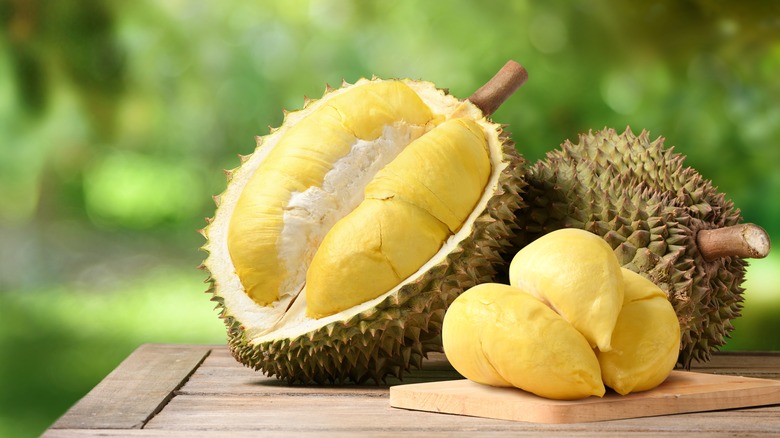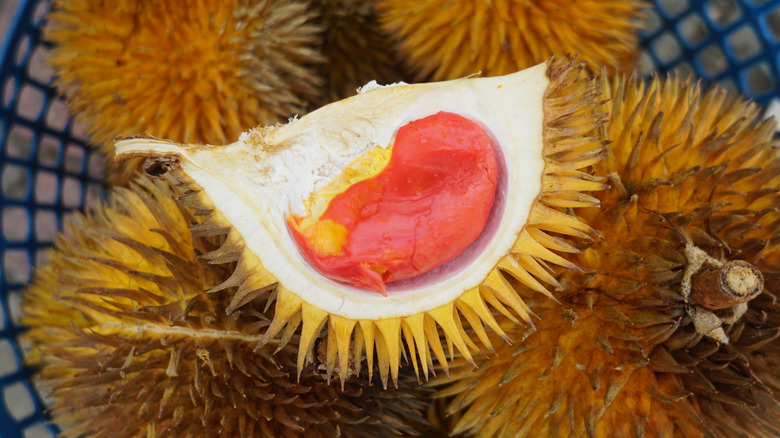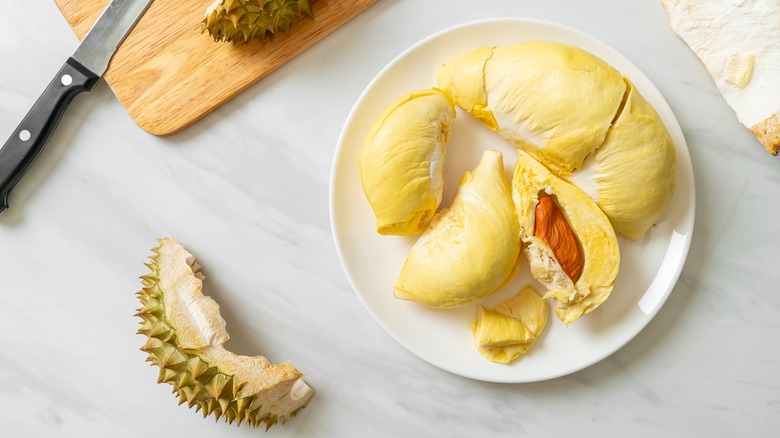Durian Fruit Has An Infamous Smell, But What Does It Taste Like?
Even if you've never seen a durian fruit, you've probably heard about its overwhelming odor. It's so potent that the fruit has been banned from hotels and public transit systems in Singapore, Thailand, Japan, and Hong Kong. It's been the subject of countless disparaging remarks and comparisons, but the truth is more complicated than that. Research has revealed that durian contains aromatic compounds linked to sulfur, rotten onions, cabbage, and natural gas leaks — but it also contains exceptionally high concentrations of fruity compounds, which can be appealing. Unfortunately, the negative aspects of durian's smell have so overshadowed its reputation that most people haven't even bothered to find out what it tastes like.
Most of the time, you can accurately guess the taste of a food based on its smell — not with durian. While its aroma has been likened to Limburger cheese and old socks, its flavor earns comparisons to caramel and vanilla. It is predominantly sweet, making it a popular ingredient in desserts. However, there is also a funky, savory undertone that some liken to garlic. The fruit's pale flesh has a creamy, custard-like texture, soft enough to slurp. As with its smell, the flavor of durian elicits polarizing opinions. You'll have to try it yourself to decide whether it truly is, as many in Southeast Asia say, "The King of Fruits."
There are hundreds of durian varieties
Durian flavor is not a singular thing, as it varies depending on which type you eat. It is estimated that there could be more than 500 varieties of durian, although most of them are not grown commercially. Broadly speaking, durian types fall into one of two categories: sweet-leaning or bitter-leaning and their intensity can vary dramatically.
Common types of sweet-leaning durian include Hor Lor, which has a drier texture than most other varieties; Red Prawn, which has orange flesh; and Monthong, which has a milder smell making it an excellent entry point for durian newbies. On the bitter end of the spectrum, you have Chanee, which grows more and more bitter as it ripens; Tawa, with a mellow bitterness; and XO durian, which is infamous for its strong alcoholic aftertaste.
There are also durian varieties that offer a balance of bitter and sweet, opening up a broader spectrum of flavor. These include Musang King — also known as Mao Shan Wang — which has a rich, buttery texture and a characteristic star-shaped pattern on its bottom. Despite having a more pungent smell than most other types of durian, it is the world's most popular variety. The D24, a.k.a. Sultan durian, is another fan favorite and an excellent choice for newbies as its aroma is on the milder side.
What to do with durian
An incredibly versatile fruit, there are many ways to eat durian. These include sweet and savory options, including candies, chips, and ice cream. Pizza Hut even sold a durian-topped pizza for a while at locations in China. The purest way to eat durian, though, is the simplest: fresh and raw. Some prefer to do this with a fork and knife to keep the smell of durian from lingering on their hands, but this is not traditional and is even a source of controversy. In 2019, Raja Permaisuri Agong Tunku Azizah Aminah Maimunah Iskandariah, the Queen consort of Malaysia, issued a public apology after photographs showed her eating durian with utensils.
Before you can eat durian, you have to extract its pulp. This can be daunting, as the outer shell is covered in spikes, like a jackfruit but even sharper. You might want to wear rubber gloves when you handle it (which will also keep the smell off your hands). Look for seams in the durian shell, where the spikes are pointed slightly inwards, then wedge a knife in there and slice the shell from top to bottom. When you pry it open, you'll see that the flesh is clustered in pods, each composed of a seed surrounded by a generous amount of creamy pulp. You can suck the pulp right off the seed or separate it to use in the sweet or savory dish of your choice.


